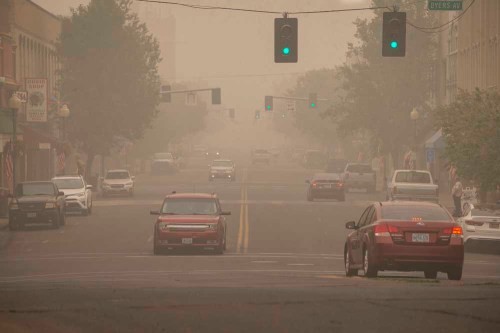Could Oregon’s wildfire smoke lead to a bad flu season and a coronavirus spike?
Published 8:03 am Friday, September 18, 2020

- Cars traverse the smoke-filled downtown corridor in Pendleton on Friday, Sept. 11, 2020.
PORTLAND — Wildfires are still burning as much of Oregon and the West Coast begin to very slowly emerge from thick clouds of hazardous smoke. As the smoke clears, the question of what exposure to that air will mean as Oregonians head into flu season during the coronavirus pandemic looms on the horizon.
While no data yet exists that can directly answer the question of what long term health issues people exposed to Oregon’s smoke might be in for, scientists in Montana may have a clue to what we can expect this winter. In a study published in March, researchers found an interesting correlation between wildfires and flu cases months later.
Trending
“We show that across 10 years of Montana’s data, comparing bad fire seasons to non-bad fire seasons,” said Erin Landguth, lead author on the study Thursday, “one would expect to see a three to possible five times worse flu season.”
Landguth, who studies ecology and public health at the University of Montana, offered plenty of caveats to the study’s findings — it is solely based on Montana, and shows only correlation, not causation.
But, she noted, “It’s a piece of the puzzle.”
The Montana study considered entire fire seasons and the tiny particulate matter — PM2.5 — those fires put in the air. Oregon and the West are in the midst of one acute event featuring PM2.5 particulates as well, but the fire season is not done yet, so it is impossible to say with certainty what that research could mean here.
But Landguth expects this summer to be “one of our worst air quality seasons.”
“We can’t compare this season to all the other seasons yet, until we get done with this season,” she said, “but we’re already seeing off the charts numbers.”
Trending
How wildfire smoke leads to flu spikes is still unknown. But studies in other places have already made the connection between air pollution and a more immediate risk of flu, Landguth said.
“If you accumulate PM2.5 in your system for a day, maybe a week, you have higher risk for flu,” Landguth said. “This is known.”
The connection between pollution and illness extends beyond flu to a disease we now know is far more deadly: COVID-19.
“We have seen in the U.S. and around the world that higher air pollution exposures are linked to increased vulnerability to COVID,” Landguth said noting that she knows of 16 studies put out since the beginning of the pandemic, across the world, that link air pollution and COVID-19.
There has not been a study linking wildfire smoke and COVID-19, she said, because “we’re just now experiencing it.”
But she did note that the Centers for Disease Control and Prevention have updated their website.
It now reads: “Wildfire smoke can irritate your lungs, cause inflammation, affect your immune system, and make you more prone to lung infections, including SARS-CoV-2, the virus that cause COVID-19.”
“We know, from decades of wildfire research, that some people are more at risk of harmful health effects from wildfire smoke than others,” Landguth said.
“This is the sensitive group population,” she said. “This is about 30% of us.”
Children, pregnant women, adults over 65 and people with chronic health conditions, outdoor workers and people experiencing homelessness all fall into this category.
There’s a good amount of overlap between the group at risk from wildfire smoke and the group at risk for severe COVID-19.
Public health officials in Oregon also worry that smoke inhalation from the wildfires “could potentially increase the severity of COVID-19” among people who become infected, said Dr. Melissa Sutton, medical director for respiratory viral pathogens at the Oregon Health Authority.
But, she cautioned, “We honestly don’t know” because so much is still being learned about the disease.
There is one reason to believe that even with the wildfire smoke Oregonians might be spared spikes in disease this fall and that is the pandemic itself.
Countries in the Southern Hemisphere saw a mild flu season, and state officials are hopeful transmission to the north will be minimal as so many people worldwide embrace physical distancing and personal hygiene practices to slow COVID-19.









